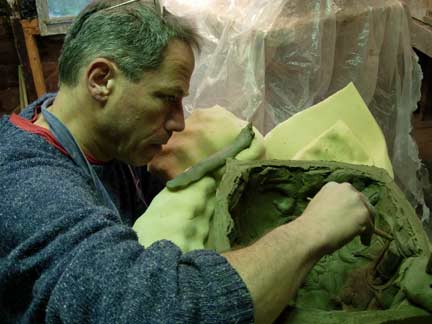
I always loved the sights, sounds, and experience of the rural Vermont
landscape that I was born into: the interconnectedness of the farmhouse, the
barn, the grange, the one room schoolhouse, the church, and the town hall.
All of these expressed a compelling and intimate personal, religious and
communal world. I was powerfully drawn to this world but it did not resonate
with my own cultural history. When I gazed into our barn with its cathedral-like grandeur, I could only envy the sense of destiny and purpose that
gripped its builders; I could not help but be in awe of it. Another part of
me, though, had to believe that there was another story yet to be told—one
that was also mine.
I was visually introduced to the world that my grandparents had inhabited when, as an adult, I saw for the first time photographs of Eastern European wooden shules (synagogues) and gravestones. Here I saw a narrative with many of the same individual and communal elements as mine, but set in different religious, cultural and historical time. I felt especially connected to the vernacular architecture of the wooden shules and the bold imagery and Hebrew text that adorned their tent-shaped interiors. This decoration not only transformed these plain wooden interiors into resplendent sanctuaries, but was often a reflection of an intensely focused social, political and religious agenda.
Primarily using clay, but often incorporating wood, archival materials and found objects, my work communicates the narratives, texture and spirit of real and imagined places that once existed throughout many parts of the Jewish world. The work, while visually connected to the past, can be seen as a contemporary midrash (interpretation) combining beauty and function; my hope is that it will be integrated into the fabric of people’s daily lives, becoming a tangible and useful reminder of a rich and enduring story.
I was visually introduced to the world that my grandparents had inhabited when, as an adult, I saw for the first time photographs of Eastern European wooden shules (synagogues) and gravestones. Here I saw a narrative with many of the same individual and communal elements as mine, but set in different religious, cultural and historical time. I felt especially connected to the vernacular architecture of the wooden shules and the bold imagery and Hebrew text that adorned their tent-shaped interiors. This decoration not only transformed these plain wooden interiors into resplendent sanctuaries, but was often a reflection of an intensely focused social, political and religious agenda.
Primarily using clay, but often incorporating wood, archival materials and found objects, my work communicates the narratives, texture and spirit of real and imagined places that once existed throughout many parts of the Jewish world. The work, while visually connected to the past, can be seen as a contemporary midrash (interpretation) combining beauty and function; my hope is that it will be integrated into the fabric of people’s daily lives, becoming a tangible and useful reminder of a rich and enduring story.
